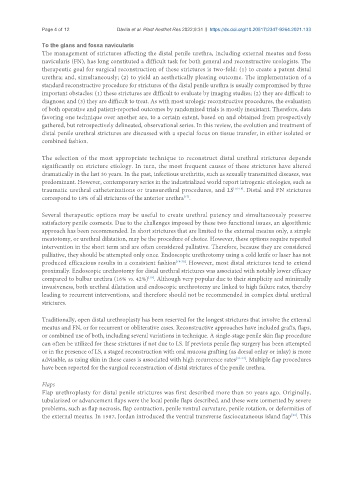Page 64 - Read Online
P. 64
Page 4 of 12 Dávila et al. Plast Aesthet Res 2022;9:31 https://dx.doi.org/10.20517/2347-9264.2021.133
To the glans and fossa navicularis
The management of strictures affecting the distal penile urethra, including external meatus and fossa
navicularis (FN), has long constituted a difficult task for both general and reconstructive urologists. The
therapeutic goal for surgical reconstruction of these strictures is two-fold: (1) to create a patent distal
urethra; and, simultaneously; (2) to yield an aesthetically pleasing outcome. The implementation of a
standard reconstructive procedure for strictures of the distal penile urethra is usually compromised by three
important obstacles: (1) these strictures are difficult to evaluate by imaging studies; (2) they are difficult to
diagnose; and (3) they are difficult to treat. As with most urologic reconstructive procedures, the evaluation
of both operative and patient-reported outcomes by randomized trials is mostly inexistant. Therefore, data
favoring one technique over another are, to a certain extent, based on and obtained from prospectively
gathered, but retrospectively delineated, observational series. In this review, the evolution and treatment of
distal penile urethral strictures are discussed with a special focus on tissue transfer, in either isolated or
combined fashion.
The selection of the most appropriate technique to reconstruct distal urethral strictures depends
significantly on stricture etiology. In turn, the most frequent causes of these strictures have altered
dramatically in the last 30 years. In the past, infectious urethritis, such as sexually transmitted diseases, was
predominant. However, contemporary series in the industrialized world report iatrogenic etiologies, such as
traumatic urethral catheterizations or transurethral procedures, and LS [16-18] . Distal and FN strictures
[17]
correspond to 18% of all strictures of the anterior urethra .
Several therapeutic options may be useful to create urethral patency and simultaneously preserve
satisfactory penile cosmesis. Due to the challenges imposed by these two functional issues, an algorithmic
approach has been recommended. In short strictures that are limited to the external meatus only, a simple
meatotomy, or urethral dilatation, may be the procedure of choice. However, these options require repeated
intervention in the short term and are often considered palliative. Therefore, because they are considered
palliative, they should be attempted only once. Endoscopic urethrotomy using a cold knife or laser has not
produced efficacious results in a consistent fashion [19-20] . However, most distal strictures tend to extend
proximally. Endoscopic urethrotomy for distal urethral strictures was associated with notably lower efficacy
[19]
compared to bulbar urethra (16% vs. 42%) . Although very popular due to their simplicity and minimally
invasiveness, both urethral dilatation and endoscopic urethrotomy are linked to high failure rates, thereby
leading to recurrent interventions, and therefore should not be recommended in complex distal urethral
strictures.
Traditionally, open distal urethroplasty has been reserved for the longest strictures that involve the external
meatus and FN, or for recurrent or obliterative cases. Reconstructive approaches have included grafts, flaps,
or combined use of both, including several variations in technique. A single-stage penile skin flap procedure
can often be utilized for these strictures if not due to LS. If previous penile flap surgery has been attempted
or in the presence of LS, a staged reconstruction with oral mucosa grafting (as dorsal onlay or inlay) is more
advisable, as using skin in these cases is associated with high recurrence rates [21-22] . Multiple flap procedures
have been reported for the surgical reconstruction of distal strictures of the penile urethra.
Flaps
Flap urethroplasty for distal penile strictures was first described more than 50 years ago. Originally,
tubularized or advancement flaps were the local penile flaps described, and these were tormented by severe
problems, such as flap necrosis, flap contraction, penile ventral curvature, penile rotation, or deformities of
the external meatus. In 1987, Jordan introduced the ventral transverse fasciocutaneous island flap . This
[23]

